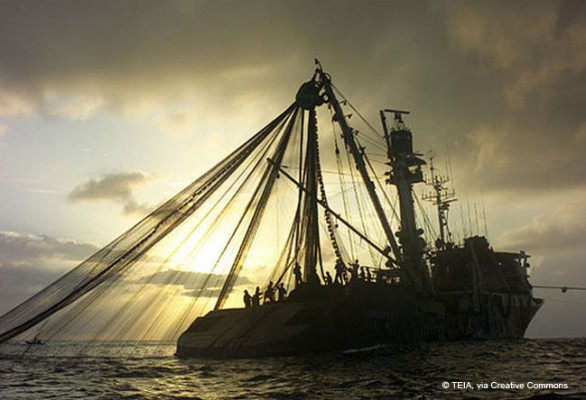Fisheries bycatch is the greatest threat to many seabird populations (tuna long-liner pictured above), especially albatross. Seabirds are attracted to fishing boats because of the bait and discarded offal, and are at risk of getting tangled in the fishing gear and drowning. The tubenoses (e.g. shearwaters, albatross, fulmars) are the most common group of seabirds caught in fishing gear because of the long-distances they travel at sea. It’s been estimated that an average of 5000 seabirds were killed each year in Alaska Bering Sea long-line fisheries (between 2002-2006). Most common species killed were the northern fulmar, glaucous-winged gull, short-tailed shearwater, black-footed albatross, laysan albatross, and the short-tailed albatross.
It’s been estimated that an average of 5000 seabirds were killed each year in Alaska Bering Sea long-line fisheries (between 2002-2006). Most common species killed were the northern fulmar, glaucous-winged gull, short-tailed shearwater, black-footed albatross, laysan albatross, and the short-tailed albatross.
Seabird Bycatch in long-line fisheries: Seabirds are at risk of getting caught on the fishing hooks between the time the hooks leave the fishing boat and the time they sink below the diving depth of the foraging seabird. Prevention methods are designed to prevent contact between the birds and the hooks during this critical period.
Seabird Bycatch in Trawl-fisheries: Seabirds can be killed by collisions with fishing cables or entangled in the net itself.
What can we do?
There are several simple (mitigation) methods that can reduce the number of seabirds killed in long-line and trawl fisheries. Methods for trawl fisheries either focus on deterring birds from making contact with cables or reducing the attractiveness of the fishing boat by managing the discharge of the offal differently.
Methods for long-line fisheries can be divided into four main categories:
1) Avoid fishing in areas and at times when seabird interactions are most likely and intense (e.g., commercial fish at night)
2) Limit bird access to baited hooks (e.g., underwater setting funnel)
3) Deter birds from taking baited hooks (e.g., streamer (bird-scaring lines)).
4) Reduce the attractiveness or visibility of the baited hooks (e.g., using artificial baits).
Learn more at:
Birdlife.org
NOAA

